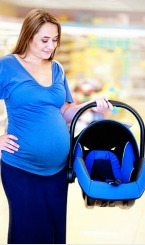Rear-facing-only car seats are extremely popular among today's busy parents. And travel systems make it possible for you to carry baby from the car, to the store, to stroller, and back to the car without ever having to remove the baby from her seat.
While the portability and convenience are appealing, the American Academy of Pediatrics (AAP) reminds parents that there are health consequences when babies spend too much time in their car seats outside of the car.
Before Travel Systems…
Before these systems came around ("back in the day"), a mother would have held baby in her arms and carried her to the car. She would have placed baby in the car seat, then removed her and put her in the stroller. All the while, baby was able to enjoy her mother's loving touch and use the muscles in her trunk and neck while being held.
Health consequences around leaving babies in car seats too long:
Flat head. A baby's head is soft, and when left in one position for too long, it deforms and reshapes accordingly causing a
positional skull deformity. This is common for babies who sleep, as they should, on their backs, and is considered normal in virtually all cases, resolving on its own when the child starts rolling and sitting. However, too much time in the car seat can make it more pronounced.
Breathing concerns. Sitting at an angle can affect infant breathing, especially for younger newborns, and especially for preemies. While it may seem counter-intuitive, sitting at an angle is worse for
reflux. If the baby's head flops forward, it can narrow his or her airway―which can lead to serious problems. It is actually better for younger infants to lie flat. Parents should be mindful of the amount of time their baby is sitting at an angle and consider changing positions, either with an adjustable stroller or a front pack, if appropriate. It is also important to be aware of the baby's head position, to make certain it has not flopped forward.
Shortened neck muscle. When in a car seat, many babies tilt their head to one side. With the head constantly to one side, the neck muscles on that side can tighten, a condition known as positional
torticollis. While most babies will not be affected, it can be worsened by repeated prolonged positioning.
Reminders for Parents:
Give baby travel breaks.-
Of course, brief periods in a car seat are not a problem, and car seats are essential on every ride to prevent injury or death in the event of a crash. But if baby has a lot of travel time in her schedule, it's important to stop and give her occasional breaks from the car seat and limit the amount of time she spends in other types of baby gear such as freestanding swings and bouncy chairs. These items all put added pressure on the back of the baby's head.
Remember tummy time.
- Spend time holding the baby in your arms as well as watching her play on the floor, both on her tummy and on her back.
See Back to Sleep, Tummy to Play for more information and ways to play with the baby during tummy time.
Transfer a sleeping baby to a safe sleep space when not traveling.- If baby falls asleep while riding in his car seat―which often happens―the AAP recommends transferring him out of the seat when you reach your destination and placing him in a crib or other safe sleep space to finish his nap. Car seats and other sitting devices, like swings or reclined bouncy seats, are not safe sleeping environments. If this is not possible, it is important for an adult to keep a close and constant eye on the infant.
For safety's sake, repeat this phrase:
Car seats are for traveling, cribs are for sleeping.
|
Physical Strain on Parents:
 The AAP recommends keeping infants and toddlers rear-facing as long as possible, until they reach the highest weight or height allowed by their car safety seat manufacturer. This means that parents will be contorting, bending, and lifting even longer. The AAP recommends keeping infants and toddlers rear-facing as long as possible, until they reach the highest weight or height allowed by their car safety seat manufacturer. This means that parents will be contorting, bending, and lifting even longer. Rear-facing-only car seats can weigh up to 10 pounds or more, so when combined with the weight of your baby (most rear-facing-only seats are used for babies up to 22 to 35 pounds), this can put a lot of strain on parents' back, shoulders, and arms. What's the best way to avoid back aches and pains?Don't get into the habit of holding your baby on one side only. Alternate arms to avoid placing undue stress on one side of your body. Remember to use legs and thighs, rather than arms, when lifting and carrying your baby. When the load gets heavy, consider switching to a convertible or 3-in-1 car seat used rear-facing; these stay installed in the car, so you only have to carry your baby, not the car seat.
|
Additional Information: